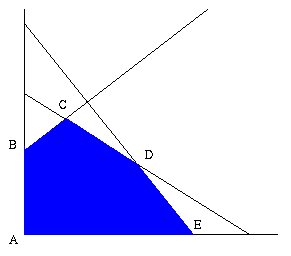It can be proven that the optimal solution to a linear program will occur at one of the vertices of the feasibility region. The feasibility region is the set of all points that satisfy the constraints. Consider Figure 1. Figure 1 shows the graph of the feasibility region for the the following constraints.

The optimal solution can be at points A, B, C, D, or E. Intuitively, the reduced costs indicate if there is an edge from the current vertex that we can traverse to improve the current solution. There can be many such edges.
The reduced costs are calculated by solving the system of equations piT B =
cBT where cB is the cost of the basic variables.
Similarly you can calculate pi by solving BT pi = cB. The reduced
costs for each nonbasic variable is then calculated by solving